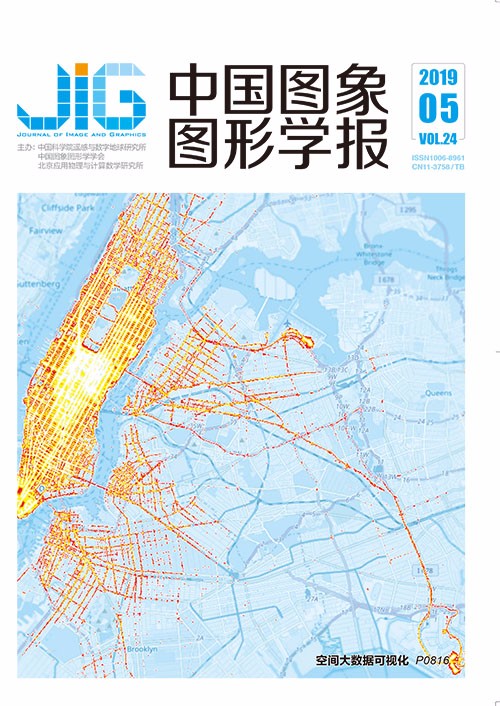
结合纹理结构的分数阶TV模型的图像修复
摘 要
目的 TV(total variation)模型在图像修复时易导致图像中具有弱导数性质的纹理和边缘细节等信息变得模糊,为了克服该缺陷,分数阶微分被引入到TV模型中,但传统的分数阶TV模型对弱边缘和弱纹理等细节信息的保持仍不够理想,并且没有充分利用图像已知区域的先验信息,修复精度仍有待提高。方法 针对该问题,提出结合纹理结构信息和分数阶TV模型的图像修复算法。改进的模型在分数阶TV模型求解时,在梯度计算过程中增加了一个极小值,克服了正则项和数据项在零点处的不可微,从而增加了模型的稳定性。再则改进的模型根据图像已知区域的先验信息确定待修复区域的纹理方向,从而更好地保持了图像中的纹理细节和弱边缘信息。结果 将本文算法与3种修复效果较好的算法进行对比,采用客观评价指标:均方差(MSE)、峰值信噪比(PSNR)和差值图像进行评价,实验结果表明本文算法在不同的纹理图像修复中均取得较好的效果,如对标准图像库中的Barbara和Lena图像以及岩石图像进行修复后,与原始TV模型相比,它们的峰值信噪比分别提高5.94%、8.07%和3.85%,灰度均方差分别降低48.66%、65.89%和35%;与分数阶TV模型相比,它们的峰值信噪比分别提高4.17%、8.59%和1.81%,灰度均方差分别降低37.90%、68.00%和18.68%。结论 提出的模型相对于原始的TV模型和分数阶TV模型,均能有效地提高图像修复的精度,适合于包含较多弱纹理和弱边缘信息的图像修复,该模型是TV模型的重要延伸和推广。
关键词
Image inpainting of fractional TV model combined with texture structure
Zhang Guimei, Li Yanbing(Key Laboratory of Image Processing and Pattern Recognition, Nanchang Hangkong University, Nanchang 330063, China) Abstract
Objective As a fundamental issue in the field of image processing, image inpainting has been widely studied in the past two decades. The goal of image inpainting is to reconstruct the original high-quality image from its corrupted observation. Notably, prior knowledge of images is important in image inpainting. Thus, designing an effective regularization to represent image priors is a critical task for image inpainting. The TV(total variation) model usually exploits local structures and high effectiveness to preserve image edges; thus, it has been found to be widely used in image inpainting. However, the regular term of the TV model is a first-order differential, which usually loses image details and tends to suffer from over-smooth effects owing to the piecewise constant assumption. Fortunately, fractional differential is capable of enhancing low-and intermediate-frequency signals and amplifying high-frequency signals moderately; thus, it is introduced into the TV model. However, the existing fractional TV model is limited with regard to its preservation of the information of images with texture and edge details. Furthermore, it does not fully use prior information such as known edges and textures. Method To address these problems, we propose a new fractional-order TV model that introduces texture structure information into a fractional TV model for image inpainting. A minimum value is used in the TV model to calculate the image gradient when solving the fractional model. Thus, the improved model is robust because it overcomes the problem of the model being non-differentiable at zero point. In this way, the weak texture information is effectively preserved. The improved model determines the texture direction of the region to be restored on the basis of the priors of the known region of the image and fully uses the texture information of the image to improve the accuracy of image inpainting. Result The Barbara and Lena images are selected as test images. The Barbara image presents a large weak texture area. By contrast, the Lena image includes few texture regions and a highly smooth area. Therefore, these two images are used for the experiment. To improve efficiency, we intercept the texture part of the original image and conduct many experiments by using differently sized templates and different orders of fractional differential. Then, the optimal parameters for different images, such as template size and order, can be obtained. The optimal parameters for the Barbara and Lena images are as follows. For the Barbara image, the optimal order is 0.1, and the optimal template size is 3×3 pixels; for the Lena image, the optimal order is 0.9, and the optimal template size is 5×5 pixels. The algorithm is compared with three algorithms with better restoration effects. Mean square error (MSE) and peak signal-to-noise ratio (PSNR) are introduced to evaluate the performance of the different methods. Experimental results indicate that the proposed algorithm achieves improved inpainting result. Unlike that in the TV model, the PSNR values after the restoration of the Barbara, Lena, and Rock images in the proposed method increase by 5.94%, 8.07%, and 3.85%, respectively; and the MSE values decrease by 48.66%, 65.89%, and 35%, respectively. Relative to the fractional TV model, the proposed method achieves PSNR values for the Barbara image, Lena image, and Rock image that increase by 4.17%, 8.59%, and 1.81%, respectively; its MSE values decrease by 37.90%, 68.00%, and 18.68%, respectively. Conclusion The relationship between inpainting effect, template order, and template size is are demonstrated in experiments, thereby providing the basis for selecting optimal parameters. Although the optimal parameters of different types of images are different, the optimal inpainting order is generally between 0 and 1 because the smooth part of the image corresponds to the low-frequency part of the signal. The texture details of the image correspond to the intermediate-frequency part of the signal. Meanwhile, the TV algorithm is not ideal for the weak texture region. To enhance the gradient information of the region, we must improve the low-and intermediate-frequency parts. Therefore, choosing the order between 0 and 1 is recommended. Furthermore, although the optimal order varies with the type of the image, a weak texture region usually results in a small order. Theoretical analysis and experimental results show that the proposed model can effectively improve the accuracy of image restoration relative to the original TV model and fractional order TV model. The proposed model is suitable for inpainting images with weak texture and edge information. This model is an important extension of the TV model.
Keywords
|



 中国图象图形学报 │ 京ICP备05080539号-4 │ 本系统由
中国图象图形学报 │ 京ICP备05080539号-4 │ 本系统由